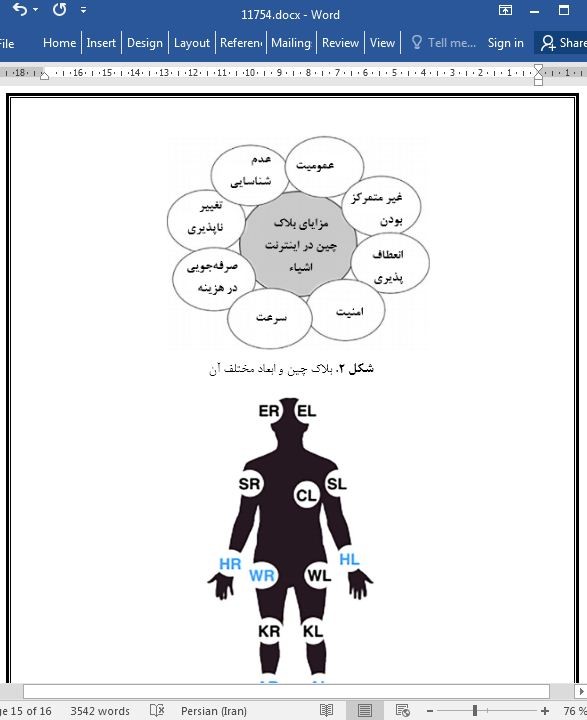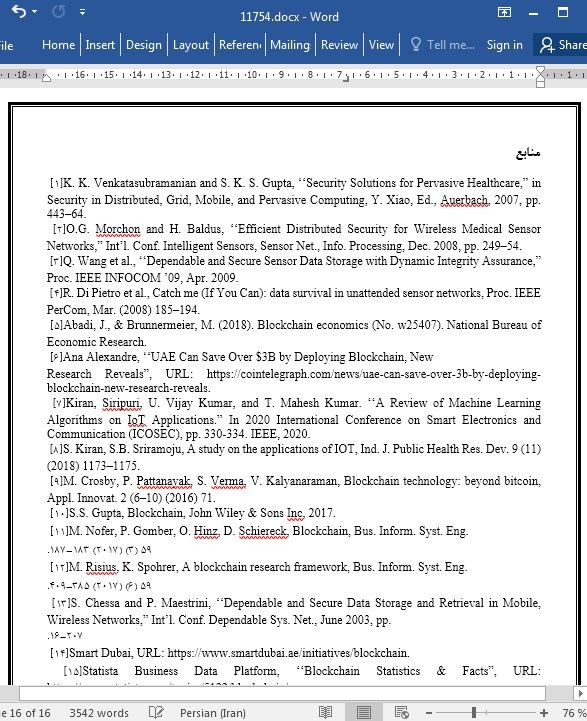
یکپارچه سازی فناوری بلاک چین جهت امنیت و حفظ حریم خصوصی اینترنت اشیاء
چکیده
امروزه، فناوری بلاک چین در کانون توجهات است و دلیل آن، ویژگیهای بسیاری است که این فناوری در حوزه امنیت، حفظ حریم خصوصی و یکپارچهسازی تبادلات در محیط شبکه ایجاد کرده است. بلاک چین عبارت است از سوابق (اطلاعات) مرتبط با یکدیگر و دارای سطح امنیتی بسیار بالا. این سطح امنیتی از طریق هشینگ پویا و انجام رمزنگاری در هر مرحله از تبادل ایجاد میشود. فناوری بلاک چین از امکان هک، نفوذ سهوی یا عمدی به تبادلات جلوگیری میکند. میتوان از بلاک چین برای پردازش دادههای حسگر استفاده کرد و از تکثیر دادههای مخرب جلوگیری نمود. اجرای سیستم اینترنت اشیاء ممکن است با چالشهایی روبهرو شود؛ به همین دلیل توصیه میشود برای ارتباط پیوسته و امن دستگاههای اینترنتی از دفتر کل توزیع شده جهت شناسایی و تایید اعتبار استفاده شود. این مقاله الگوهایی برای استفاده از شبکه بیسیم حسگر بدن جهت پیادهسازی فناوری بلاک چین ارایه میدهد. در این الگوها از اسکریپتهای پیشرفته و برنامهنویسی سالیدتی استفاده شده است. روش یکپارچهسازی فناوری بلاک چین در مقایسه با روش سنتیِ امنیت از طریق رمزنگاری از اثربخشی بیشتری برخوردار است.
6. نتیجهگیری
بلاک چین یک پایگاه داده غیر متمرکز دیجیتال است که از اسناد توزیع شده و عمومی در قالب تعدادی بلوک تشکیل شده است. از این بلوکها برای تبادل اسناد بین دستگاههای مختلف استفاده میشود. بلاک چین از ایجاد تغییر در بلوک ارسـال شده بدون تغییر دادن بلوکهای بعدی جلوگیری میکند. این قابلیت کاربران را قادر میسازد تا بدون محدودیت و با هزینه پایین تبادلات را بررسی و بازرسی کنند. شبکه غیر متمرکز و سرور تایم استمپ باعث حفظ و نگهداری بلاک چین میشوند (17). احراز هویت آنها از طریق مشارکت متقابل انجام میشود. چنین طراحی باعث میشود زمانی که شرکتکنندگان در مورد حریم خصوصی دادهها با یکدیگر اختلاف ناچیزی دارند سیستم به کار خود ادامه دهد.
Abstract
Now days, the Blockchain Technology is in focus because of its enormous features associated with privacy, security and integrity of the transactions in the network environment. A blockchain refers to a chain of records which are interconnected with each other and highly secured because of the dynamic hash and cryptography implemented at every phase of the transaction. The blockchain technology avoids the possibilities of hacking or cracking the transactions by intentional or accidental attempts. Blockchain can be used for the calculation of sensor data and avoid replication of other malicious data. IoT system implementations can be challenging and a distributed ledge is ideal to identify, authenticate and switch IoT devices seamlessly safely. This paper is presenting the usage patterns of Wireless Body Area Networks with the implementation patterns of Blockchain Technology using advanced scripts of Solidity and embedded programming. The presented integration of implementation is giving the effectual results with the blockchain technology as compared to the traditional approach of security using cryptography.
6. Conclusion
A blockchain is a decentralised digital digital database decentralising, distributed and mostly public documents called blocks which are used to document transactions on several machines and make it difficult to retroactively undo any inferred block without changing any subsequent blocks. This enables participants to freely and reasonably inexpensively check and inspect transactions. The independent use of a peer to peer network and distributed time stamp server is the maintenance of a blockchain database [17]. They’re authenticated through mutual selfinterest-led partnership. This architecture makes for solid workflows where the confusion among participants over data privacy is negligible.
چکیده
1. مقدمه
2. بررسی موردی بلاک چینها و پیادهسازی آنها
2.1 شبکههای حسگر بدن (BAN) : نمونههای کلیدی اینترنت اشیاء در پیادهسازی بلاک چین
2.2 شبکه ناحیهای درون بدن
2.3 کاربرد پزشکی اینترنت اشیاء، شبکه حسگر بدن و بلاک چین
2.4 کاربردهای غیر پزشکی
.3 فناوریهای کلیدی و چارچوبهای پیادهسازی بلاک چین
3.1 اریس
3.2 هیدراچِین
3.3 اوپنچین
3.4 اتریوم
3.5 هایپرلجر
4.ایجاد و راهاندازی بلوکها در فناوری بلاک چین
5. ایجاد بلاک چین پویا
6. نتیجهگیری
منابع
Abstract
1. Introduction
2. Blockchains case studies and implementations
2.1. Body area networks (BAN) as key IoT implementation of blockchain
2.2. Implanted body area network (IBAN)
2.3. Medical applications of IoT, BAN and blockchain
2.4. Non-medical applications
3. Key technologies and frameworks for blockchain implementations
3.1. Eris
3.2. HydraChain
3.3. OpenChain
3.4. Ethereum
3.5. Hyperledger
4. Creating and triggering blocks with WBAN and blockchain technology
5. Dynamic blockchain creation
6. Conclusion
References
- اصل مقاله انگلیسی با فرمت ورد (word) با قابلیت ویرایش
- ترجمه فارسی مقاله با فرمت ورد (word) با قابلیت ویرایش، بدون آرم سایت ای ترجمه
- ترجمه فارسی مقاله با فرمت pdf، بدون آرم سایت ای ترجمه



